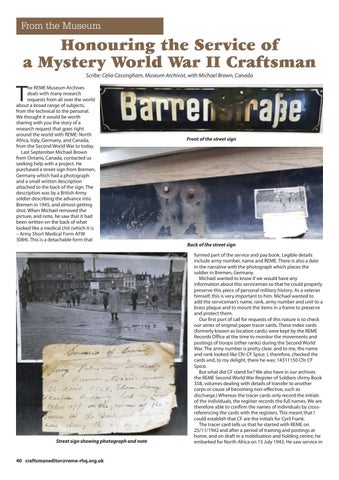From the Museum
Honouring the Service of a Mystery World War II Craftsman Scribe: Celia Cassingham, Museum Archivist, with Michael Brown, Canada
T
he REME Museum Archives deals with many research requests from all over the world about a broad range of subjects, from the technical to the personal. We thought it would be worth sharing with you the story of a research request that goes right around the world with REME: North Africa, Italy, Germany, and Canada, from the Second World War to today. Last September Michael Brown from Ontario, Canada, contacted us seeking help with a project. He purchased a street sign from Bremen, Germany which had a photograph and a small written description attached to the back of the sign. The description was by a British Army soldier describing the advance into Bremen in 1945, and almost getting shot. When Michael removed the picture, and note, he saw that it had been written on the back of what looked like a medical chit (which it is – Army Short Medical Form AFW 3084). This is a detachable form that
Front of the street sign
Back of the street sign
Street sign showing photograph and note
40 craftsmaneditor@reme-rhq.org.uk
formed part of the service and pay book. Legible details include army number, name and REME. There is also a date in the narrative with the photograph which places the soldier in Bremen, Germany. Michael wanted to know if we would have any information about this serviceman so that he could properly preserve this piece of personal military history. As a veteran himself, this is very important to him. Michael wanted to add the serviceman’s name, rank, army number and unit to a brass plaque and to mount the items in a frame to preserve and protect them. Our first port of call for requests of this nature is to check our series of original paper tracer cards. These index cards (formerly known as location cards) were kept by the REME Records Office at the time to monitor the movements and postings of troops (other ranks) during the Second World War. The army number is pretty clear, and to me, the name and rank looked like Cfn CF Spice. I, therefore, checked the cards and, to my delight, there he was: 14311150 Cfn CF Spice. But what did CF stand for? We also have in our archives the REME Second World War Register of Soldiers (Army Book 358, volumes dealing with details of transfer to another corps or cause of becoming non-effective, such as discharge.) Whereas the tracer cards only record the initials of the individuals, the register records the full names. We are therefore able to confirm the names of individuals by crossreferencing the cards with the registers. This meant that I could establish that CF are the initials for Cyril Frank. The tracer card tells us that he started with REME on 25/11/1942 and after a period of training and postings at home, and on draft in a mobilisation and holding centre, he embarked for North Africa on 15 July 1943. He saw service in











